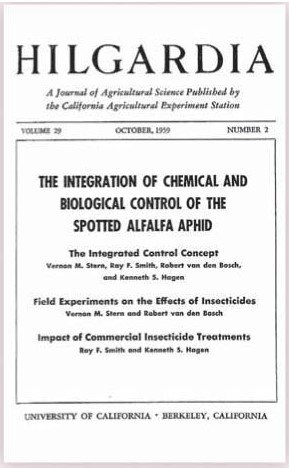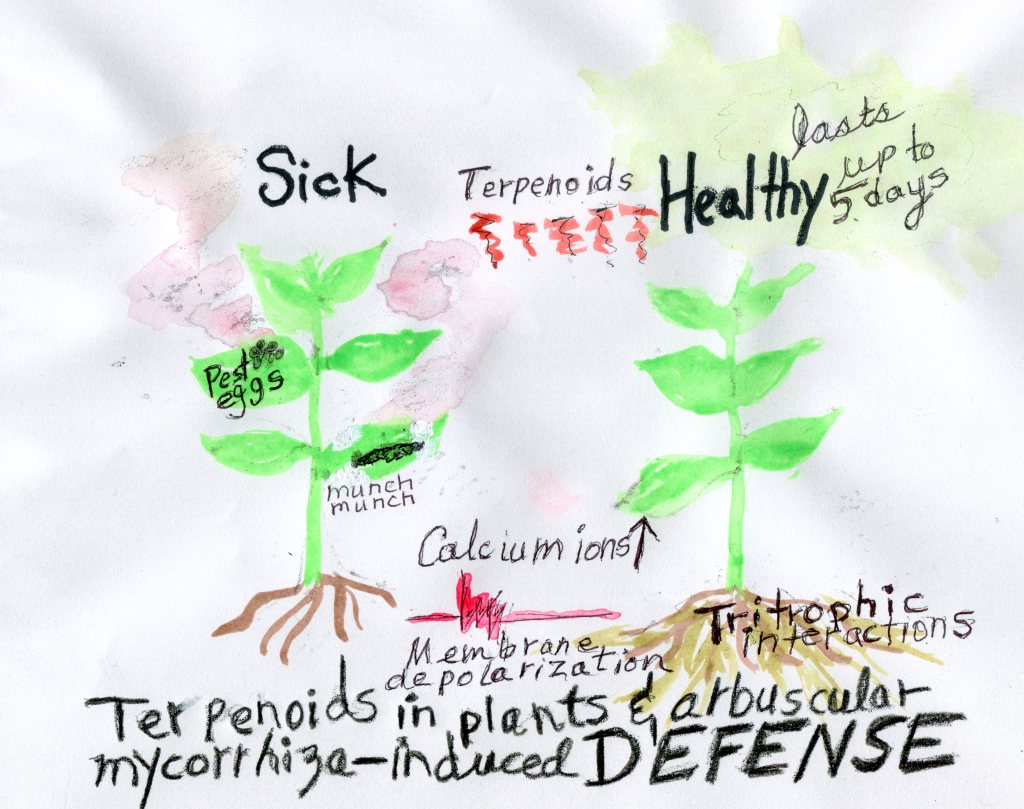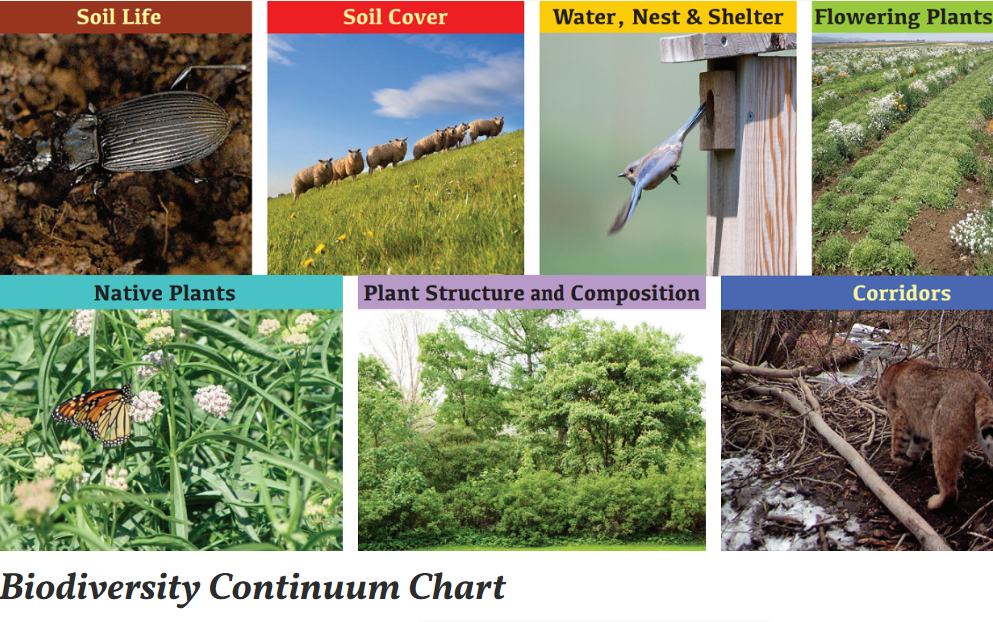Ron Whitehurst, PCA and owner Rincon-Vitova Insectaries, Inc.
The goal of the Roadmap is to offer a pathway to a future for pest management that benefits all Californians by reflecting a diverse range of considerations and stakeholder needs. There is an urban as well as an agricultural plan. Better regulation of urban pesticide use must start with a respected knowledge base that everyone can point to and apply in all situations. There is so little oversight or accountability in urban pesticide use, both for private homeowners and for public land managers. This must change!
We have five recommendations for the SPM Roadmap:
- stop requiring chemical fumigation prior to selling a house,
- educate public agencies to avoid toxic products,
- educate the community about the value of drought-tolerant, carbon-intensive, habitat-enhancing landscape designs,
- educate about new pests, and
- detox the Master Gardener Program.
STOP REQUIRING CHEMICAL FUMIGATION PRIOR TO SELLING A HOUSE
The buyer and seller should have the option of treating termites with biological and mechanical methods. They should be allowed to use a biological and mechanical option such as a biopesticide, a heat treatment and/or exclusion as needed to meet a standard of disinfestation without being required to treat with toxins.
Work with vector control and public health to develop SPM methods to manage mosquitos, eye gnats, bed bugs, rats, pigeons, cockroaches, termites, etc.
EDUCATE PUBLIC AGENCIES TO AVOID TOXIC PRODUCTS
Education must start with government agencies that use pesticides. San Francisco and Santa Monica have been working on this for a decade and are probably good models for how to do this. Work with personnel at the parks department to eliminate the use of synthetic fertilizers, herbicides and pesticides. Work with the water department to eliminate fluoride treatment and minimize chlorine.
Public spaces can be greened with vertical gardens on buildings and walls, pocket parks and verdant curb strips. This will reduce the heat island effect of too much hard scape in the city and include food producing plants. There is increasing understanding of the value of foraging to reduce food insecurity and improve public nutrition.
The Regional SPM Center, especially when it includes a cooperative grower-led insectary (described in Part 5 – “Regional SPM focus with RCDs, field scouts, food hubs and insectaries”) can offer membership to local counties, cities and school, park, and sanitation districts to help with biological control of non-agricultural pests. Collaboration among farmers and local cities and other entities can include involvement in training and employment of SPM field scouts and citizen scientists to identify problems and educate the public about solutions. Regional insectaries can offer low pricing through bulk purchase of supplies like Lo-Line Cockroach Traps and if there is enough prepaid support they can mass-rear and guide the inundative release of parasitic wasps for flies, termites and cockroaches and provide biocontrol solutions for fleas and ticks.
(l) Lo-Line Cockroach Trap is a pesticide-free sticky trap with angled entry ramp for mass-trapping most domestic cockroach species. Attractant made of food ingredients in the glue. (r) Parasitized American cockroach egg cases in release pouch placed by a trained field scout in tunnels under cafeteria where cockroaches are breeding.
One regional insectary might specialize in growing biocontrol agents for cockroaches and termites, for which parasites and pathogens are available. Field scouts associated with the insectary can put the ootheca out in areas where cockroaches are present and bring them back to the lab, and see what parasites come out. Dr. Barry Pawson of PNE, grew little parasitic wasps, about 1/10 of an inch long, that feed on the egg cases (ootheca) of cockroaches. These wasps don’t bite or sting and can be used in occupied buildings, seeking out the cockroach eggs inside the walls, between floors and other obscure areas. Programs may include sticky traps, borate based baits, and jar traps baited with bread and beer.
Dr. Pawson helped universities, hospitals, hotels, apartment houses, greenhouses and conservatories develop comprehensive long-term biological programs to manage cockroaches without using toxic pesticides. This kind of SPM service cannot be a speculative entrepreneurial venture the way Dr. Pawson tried to do it. Like all production and proper use of natural enemies, it should have front-end public funding to maintain the pest and natural enemy production for subscribed members who pay dues to support regional insect production with experienced workers for monitoring and to deploy comprehensive biological solutions.
EDUCATE THE COMMUNITY ABOUT SAFE MANAGEMENT OF NON-PLANT PESTS
Develop outreach materials showing economic benefit from low risk and biological control options from a broad perspective including monitoring and species identification, attention to the habitat and cultural considerations, effective use of low-risk biopesticides and when the introduction of a natural enemy can be cost-effective.
Ants: Borate based baits and orange oil sprays. Boric acid is a low risk active ingredient that is effective in baits with 0.5% concentration for ants.
Cockroaches: Management starts with sanitation and small tunnel-boxes with sticky floors along walls traveled by cockroaches. Food based baits (sugar, flour, milk) with 30% boric acid or a fine dust, barely visible, will kill cockroaches. As a salt, boric acid is rapidly flushed from the body, so it doesn’t build up or persist in mammals. It has an excellent toxicity profile for use in schools and public places. It’s the one pesticide that is approved for the healthy schools program.
Flies: Sanitation and fly traps are a basic program that can also include fly parasites and an entomopathic fungal spray for challenging situations.
Fleas: Here are some tips for non-toxic home flea treatments. For some properties where animals become infested outdoors, beneficial parasitic nematodes will kill flea larvae on exterior grounds, usually where there is plant cover and enough water supply to help survival and movement of the nematodes through the soil.
EDUCATE THE COMMUNITY TO VALUE DROUGHT-TOLERANT, CARBON-INTENSIVE, HABITAT-ENHANCING LANDSCAPE DESIGNS
A broad-based community health and greening program can also raise awareness about the value of regenerative organic products. One model for organizing neighborhood discussion about conservation and sustainability is exemplified by Transition Streets and Cool Blocks. These programs provide a structure for people in a neighborhood to gather and focus over eight meetings on one topic per meeting. The approach is highly participative, shaped by local needs, and resulting in significantly stronger resilience during a crisis according to a study. Water conservation, organic gardening, greenhouse gas emissions reduction, and carbon sequestration are features of these curricula that intersect with Sustainable Pest Management.
Community gardens are an ideal place for disseminating SPM information as well as food-sharing activities. In Ventura, a woman organized a monthly event on Facebook called “805 Crop Swap” in front of her church where people bring surplus home-grown produce, share and visit. Leftovers go to the food pantry. Volunteers help set up and pack up and there is an activity table for small children. When people from next door or across town get to know each other, they see possibilities for collective know-how and wisdom, fun, and mutual aid. People gain a greater sense of individual sufficiency and public wealth, versus our current cultural focus on individual wealth for a few and public poverty. It is a small potential antidote to current austerity programs that move wealth upward to people already rich in worldly goods.
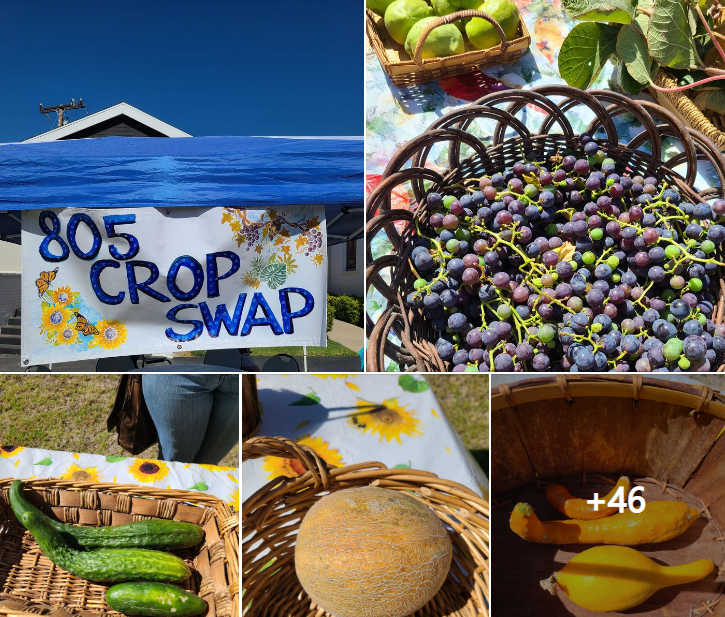
The Surfrider Foundation has an Ocean Friendly Garden program for volunteers to help provide advice and help to replace lawns with non-toxic water-conserving gardens. The “Our Water – Our World” program, on the other hand, educates garden center sales people to guide customers to low risk pesticides with shelf talkers showing toxicity of pesticides for sale. Information cards explain cultural, mechanical, biological and low risk pesticide controls for common garden pests. It has been run through the solid waste departments, with the goal of keeping pesticides out of the solid waste stream. The health department and water department would also benefit from such a program. New aesthetics for landscaping can be part of the health and greening program to show that biodiverse xerophilic gardens and vegetable beds and fruit and nut trees are beautiful and could be a resource during the food shortages that some people are forecasting. How can they be engaged to join the effort?
Cooperatives and labor unions, local food hubs and Community Supported Agriculture may also provide opportunities for outreach. People who support local farmers, especially when they are certified or equivalent to organic, are likely to welcome the opportunity to extend more knowledge about safe pest management and possibly even recruit and train neighborhood SPM Ambassadors.
Social organizing can unify people towards more ecological landscaping for public, commercial and industrial properties that may have weedy areas. A volunteer work party can offer an alternative to chemical herbicides. A weedy lawn area in Golden Gate Park, SF, was cleared of persistent weeds by periodic community work parties manually grubbing out the offending weeds. Farmer guilds in northern California have organized themselves into crop mobs (like flash mobs) on social media to come together on one farm to harvest, weed or other tasks that needed a lot of work. After work, food and socializing satisfies a need for community.
Biodiversity-based farms and farm products will before long benefit from consumer access to affordable, portable devices to measure the relative nutritional content of food choices available to them. A group can organize a lending library of tools to achieve higher standards for shopping, gardening tools (a high-end broad fork and electric tractor), and other cooperative tools and supplies.
EDUCATE ABOUT NEW PESTS
Exotic, new discoveries of pestiferous insects, mites, and plant pathogens can be a threat to agriculture. Most arrivals are benign and some arrivals are most welcome. Without the European honeybee we would not be growing numerous crops, a loss made worse by the decimation of native pollinators by neonicotinoids. The first line of defense against an invading pest should be research and foreign exploration to identify natural enemies from the country of origin to effectively control the pest through classical biocontrol colonization.
The few insect species that successfully invade can cause obvious damage to agriculture and ecosystems resulting in large economic losses. New insect pests may attack people, animals, forests, landscapes and farms, sometimes preying on native species but more often displacing them. It is likely that the full negative impacts are greater than we realize, affecting mating compatibility, genetics, and food webs.
There are many more examples of the damage from non-native plants taking over native ecosystems creating monocultures and starving or negatively affecting higher trophic levels–birds, bats, reptiles and mammals. A healthy plant community depends on biodiversity, ideally with some organisms having evolved together in that place. Indigenous food ways are affected when invasive plants displace traditional foods and medicinal plants. People may not be able to go to natural lands and waters and recreation areas affected by invasive species.
Citizen scientists may be able to make a difference, especially tracking distribution. This has been successful in confining the spread of the Asian giant hornet to Whatcom County, Washington. Karla Salp, public engagement specialist for the WSDA says,
“We know that, based on the fact that Asian giant hornets are an apex predator and usually nest in the ground or in tree cavities, it won’t be easy to find them, especially given the amount of suitable habitat. It is going to be a very big challenge to eradicate them. That being said, everything that the public is doing to help us is really giving us a fighting chance.”
She has organized highly engaging webinars and outreach to citizen scientists.
Part of SPM education is about understanding invasive species as indicators of an unbalanced ecosystem. This is especially the case with weeds. Many years ago I compiled a database called Reading Weeds: Exploring the Indicator Value of Weeds in Agriculture. It helps to know that lambsquarter and pigweed are signs of excess nitrogen, high potassium can support knapweed, and mustard and purslane in high phosphorous conditions, while oxalis likes a low calcium, high magnesium condition. Some weeds tell you the soil is excessively compacted. Weeds are valuable indicating nutrient deficiencies and excesses that can be corrected to reduce the weed’s competitive advantage.
As we face the end of civilization as we know it, let’s be open to “tomorrow’s possibilities” in the words of Tao Orion who describes nearly half of western United States plant communities being transformed by 2050 into “unpredictable assemblages of species.” Meanwhile there are scientists who question either felling or injecting trees with systemic imidicloprid to eradicate bark beetles or prevent them from killing a tree or spreading to more trees. As we presented in part 6 in this series, pests tend to attack plants experiencing malnutrition or stress [Orion, 2015]. A combination of insect-eating nematodes and insect-eating fungus will treat borers and SAR stimulants will boost the plant’s immune system to ward off disease. Trees that have genetics that resist the pest become good candidates for replanting.
While Bayer markets Bio-Advanced “Tree and Shrub Protect” at Walmart, regarding its common use to treat Emerald ash borer, Orion writes, “A healthy ash tree should be able to produce enough sap to push the ash borer larvae out of the cambium, but unhealthy trees use their sap resources to maintain basic circulation, allowing the beetle to colonize.” It has been shown that Huanglongbing (HLB), also known as citrus greening, has been reversed in the phloem of trees given high quality tree care. A local entomologist proposed to the Santa Barbara Entomology Club that allowing trees to evolve to survive the current Polyphagous shot hole borer invasion may be preferable to cutting them down and chipping them to try to eradicate the beetles.
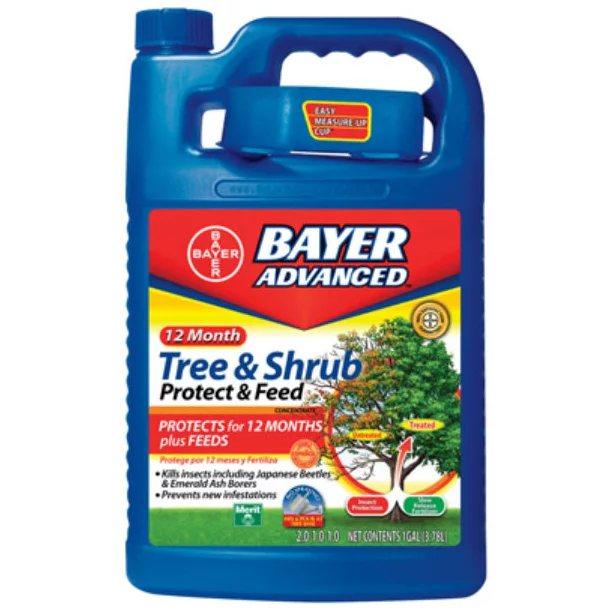
SPM needs to spread the word that soil and sap analysis to determine ideal nutrition and microbial inputs and avoiding toxic inputs is the best path to continue growing trees and shrubs under attack by invading pests.
DETOX THE MASTER GARDENER TRAINING
Friends in both Ventura County and Hawaii have shared their misery trying to survive the Master Gardener Program Training because chemical pesticides and fertilizers are such an embedded feature of the course. They say it was worth it, but they spent most of the course strategizing how to nicely suggest alternate information without offending the trainers. They appreciate the credential and some of the learning, but their aversion to the pest management component remains years later.
The Master Gardener curriculum needs an SPM make-over to align with an abundance of organic gardening know-how and resources. Every recommendation of a poison or artificial nitrogen fertilizer should be deleted and the hazards and negative impacts of gardening chemicals in all aspects of life should be taught, e.g. the gardener, her children, the garden produce, air, surface and groundwater, bees, beneficials, and soil microbes. Trainees must be required to guide consumers to use low risk organic pesticides and organic methods.
Garden centers will often have 20,000 skews or products. But we just need five things to grow a plant: air (CO2), water, sunshine, a little mineral from soil, and a seed or cutting. Seed and scion swaps serve as sources of plant material and know-how. Gardeners can learn to grow amazing plants with resources at hand.
Finally, the Master Gardener program mission should include educating the local media to report about events to promote SPM including featuring human interest stories about resourceful landscapers, gardeners and community organizers to spread the word about health risks of toxic chemical pesticides and access to alternative knowledge and supplies.
REFERENCES
Orion, Tao, Beyond the War on Invasive Species-A permaculture approach to ecosystem restoration, 2015.
Tobin PC. Managing invasive species. F1000Res. 2018 Oct 23;7:F1000 Faculty Rev-1686. doi: 10.12688/f1000research.15414.1. PMID: 30416712; PMCID: PMC6206619.
Whitehurst, Ron, Reading Weeds: Exploring the Indicator Value of Weeds in Agriculture, 2001.
